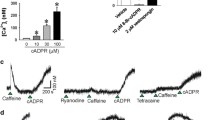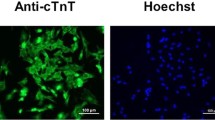Abstract
In the present study, we explored the effects of a plant alkaloid compound, 1-methoxy-3-methylcarbazole (murrayafoline A, Mu-A), on focal and global Ca2+ signaling, and the underlying cellular mechanisms. Rapid two-dimensional confocal Ca2+ imaging and image analysis were used to measure Ca2+ signals in rat ventricular myocytes. Application of Mu-A (10–100 μM) significantly enhanced the magnitude and rate of Ca2+ release on depolarization with no change in Ca2+ transient decay. Focal Ca2+ release events (Ca2+ sparks) occurred more often, and their duration and size were greater after the application of Mu-A. In addition, sarcoplasmic reticulum (SR) Ca2+ loading and fractional release were increased by exposure to Mu-A. All these effects reached steady state within 2–3 min after Mu-A application. The higher occurrence of Ca2+ sparks in the presence of Mu-A was resistant to SR Ca2+ clamping, removal of extracellular Ca2+ and Na+, and blockade of either protein kinase A, Ca2+/calmodulin-dependent protein kinase II, phospholipase C, or inositol 1,4,5-trisphosphate receptors, but it was abolished by the inhibition of protein kinase C (PKC). SR Ca2+ clamping prevented the Mu-A-induced Ca2+ spark prolongation and enlargement. The Mu-A-induced enhancement of Ca2+ transients was also eliminated by PKC blockade. Mu-A enhanced PKC activity in vitro. These results suggest that Mu-A may increase spark occurrence via its direct enhancement of PKC activity and subsequent sensitization of ryanodine receptor clusters and that this mechanism, as well as increased SR Ca2+ loading, may partly explain larger and more rapid global Ca2+ releases in the presence of Mu-A during depolarization.











Similar content being viewed by others
References
Bassani JWM, Yuan W, Bers DM (1995) Fractional SR Ca release is regulated by trigger Ca and SR Ca content in cardiac myocytes. Am J Physiol 268:C1313–C1329, PMID: 7762626
Beuckelmann DJ, Wier WG (1988) Mechanism of release of calcium from sarcoplasmic reticulum of guinea-pig cardiac cells. J Physiol 405:233–255, PMID: 2475607
Bonev AD, Jaggar JH, Rubart M, Nelson MT (1997) Activators of protein kinase C decrease Ca2+ spark frequency in smooth muscle cells from cerebral arteries. Am J Physiol 273:C2090–C2095, PMID: 9435516
Bui LT, Nguyen DT, Ambrose PJ (2006) Blood pressure and heart rate effects following a single dose of bitter orange. Ann Pharmacother 40:53–57, PMID: 16317106
Cannell MB, Cheng H, Lederer WJ (1994) Spatial non-uniformities in [Ca2+]i during excitation-contraction coupling in cardiac myocytes. Biophys J 67:1942–1956, PMID: 7858131
Carter S, Pitt SJ, Colyer J, Sitsapesan R (2011) Ca2+-dependent phosphorylation of RyR2 can uncouple channel gating from direct cytosolic Ca2+ regulation. J Membr Biol 240:21–33, PMID: 21274522
Cheng H, Lederer WJ (2008) Calcium sparks. Physiol Rev 88:1491–1545, PMID: 18923188
Cheng H, Lederer WJ, Cannell MB (1993) Calcium sparks: elementary events underlying excitation-contraction coupling in heart muscle. Science 262:740–744, PMID: 8235594
Choi H, Gwak J, Cho M, Ryu MJ, Lee JH, Kim SK, Kim YH, Lee GW, Yun MY, Cuong NM, Shin JG, Song GY, Oh S (2010) Murrayafoline A attenuates the Wnt/beta-catenin pathway by promoting the degradation of intracellular beta-catenin proteins. Biochem Biophys Res Commun 391:915–920, PMID: 19962966
Cleemann L, Morad M (1991) Role of Ca2+ channel in cardiac excitation-contraction coupling in the rat: evidence from Ca2+ transients and contraction. J Physiol 432:283–312, PMID: 1653321
Cleemann L, Wang W, Morad M (1998) Two-dimensional confocal images of organization, density, and gating of focal Ca2+ release sites in rat cardiac myocytes. Proc Natl Acad Sci U S A 95:10984–10989, PMID: 9724816
Cui CB, Yan SY, Cai B, Yao XS (2002) Carbazole alkaloids as new cell cycle inhibitor and apoptosis inducers from Clausena dunniana Levl. J Asian Nat Prod Res 4:233–241, PMID: 12450250
Cuong NM, Hung TQ, Sung TV, Taylor WC (2004) A new dimeric carbazole alkaloid from Glycosmis stenocarpa roots. Chem Pharm Bull 52:1175–1178, PMID: 15467229
Furukawa H, Wu TS, Ohta T, Kuoh CS (1985) Chemical constituents of Murraya euchrestifolia HAYATA. Chem Pharm Bull 33:4132–4138, PMID
Gómez AM, Cheng H, Lederer WJ, Bers DM (1996) Ca2+ diffusion and sarcoplasmic reticulum transport both contribute to [Ca2+]i decline during Ca2+ sparks in rat ventricular myocytes. J Physiol 496(2):575–581, PMID: 8910239
Györke I, Györke S (1998) Regulation of the cardiac ryanodine receptor channel by luminal Ca2+ involves luminal Ca2+ sensing sites. Biophys J 75:2801–2810, PMID: 8926602
Györke S, Lukyanenko V, Györke I (1997) Dual effects of tetracaine on spontaneous calcium release in rat ventricular myocytes. J Physiol 500(2):297–309, PMID: 9147318
Han S, Schiefer A, Isenberg G (1994) Ca2+ load of guinea-pig ventricular myocytes determines efficacy of brief Ca2+ currents as trigger for Ca2+ release. J Physiol 280:411–421, PMID: 7869256
Itoigawa M, Kashiwada Y, Ito C, Furukawa H, Tachibana Y, Bastow KF, Lee KH (2000) Antitumor agents, 203, carbazole alkaloid murrayaquinone A and related synthetic carbazole quinones as cytotoxic agents. J Nat Prod 63:893–897, PMID: 10924160
Janczewski AM, Spurgeon HA, Stern MD, Lakatta EG (1995) Effects of sarcoplasmic reticulum Ca2+ load on the gain function of Ca2+ release by Ca2+ current in cardiac cells. Am J Physiol 268:H916–H920, PMID:7864219
Kettlun C, González A, Rios E, Fill M (2003) Unitary Ca2+ current through mammalian cardiac and amphibian skeletal muscle ryanodine receptor channels under near-physiological ionic conditions. J Gen Physiol 122:407–417, PMID: 12975450
Kim JC, Son MJ, Subedi KP, Li Y, Ahn JR, Woo SH (2010) Atrial local Ca2+ signaling and inositol 1,4,5-trisphosphate receptors. Prog Biophys Mol Biol 103:59–70, PMID: 20193706
Kobayashi Y, Hoshikuma K, Nakano Y, Yokoo Y, Kamiya T (2001) The positive inotropic and chronotropic effects of evodiamine and rutaecarpine, indoloquinazoline alkaloids isolated from the fruits of Evodia rutaecarpa, on the guinea-pig isolated right atria: possible involvement of vanilloid receptors. Planta Med 67:244–248, PMID: 11345696
Lacerda AE, Rampe D, Brown AM (1988) Effects of protein kinase C activators on cardiac Ca2+ channels. Nature 335:249–251, PMID: 2457814
Li X, Zima AV, Sheikh F, Blatter LA, Chen J (2005) Endothelin-1-induced arrhythmogenic Ca2+ signaling is abolished in atrial myocytes of inositol-1,4,5-trisphosphate (IP3)-receptor type 2-deficient mice. Circ Res 96:1274–1281, PMID: 15933266
Lindermann JP, Jones LR, Hathaway DR, Henry BG, Watanabe AM (1983) β-Adrenergic stimulation of phospholamban phosphorylation and Ca2+-ATPase activity in guinea pig ventricles. J Biol Chem 258:464–471, PMID: 6217205
Liu QH, Zheng YM, Korde AS, Li XQ, Ma J, Takeshima H, Wang YX (2009) Protein kinase C-ε regulates local calcium signaling in airway smooth muscle cells. Am J Respir Cell Mol Biol 40:663–671, PMID: 19011160
Lokuta AJ, Meyers MB, Sander PR, Fishman GI, Valdivia HH (1997) Modulation of cardiac ryanodine receptors by sorcin. J Biol Chem 272:25333–25338, PMID: 9312152
Mackenzie L, Bootman MD, Laine M, Berridge MJ, Thuring J, Holmes A, Li WH, Lipp P (2002) The role of inositol 1,4,5-trisphosphate receptors in Ca2+ signalling and the generation of arrhythmias in rat atrial myocytes. J Physiol 541:395–409, PMID: 12042347
Marx SO, Reiken S, Hisamatsu Y, Jeyaraman T, Burkhoff D, Rosemblit N, Marks AR (2000) PKA phosphorylation dissociates FKBP12.6 from the calcium release channel (ryanodine receptor): defective regulation in failing hearts. Cell 101:365–376, PMID: 10830164
McGuffin M (2007) Effect on heart rate of bitter orange, caffeine, and exercise. Am J Med 120:e19. doi:10.1016/j.amjmed.2005.12.031
Meissner G (1994) Ryanodine receptor/Ca2+ release channels and their regulation by endogenous effectors. Annu Rev Physiol 56:485–508, PMID: 7516645
Movsesian MA, Nishikawa M, Adelstein RS (1984) Phosphorylation of phospholamban by calcium-activated, phospholipid-dependent protein kinase. J Biol Chem 259:8029–8032, PMID: 6234308
Näbauer M, Callewaert G, Cleemann L, Morad M (1989) Regulation of calcium release is gated by calcium current, not gating charge, in cardiac myocytes. Science 244:800–803, PMID: 2543067
Niggli E, Lederer WJ (1990) Voltage-independent calcium release in heart muscle. Science 250:565–568, PMID: 2173135
Ogrodnik J, Niggli E (2010) Increased Ca2+ leak and spatiotemporal coherence of Ca2+ release in cardiomyocytes during β-adrenergic stimulation. J Physiol 588:225–242, PMID: 19900959
Pereira L, Mélanie M, Fernández-Valasco M, Lucas A, Leroy J, Perrier R, Morel E, Fischmeister R, Richard S, Bénitah JP, Lezoualc’h F, Gómez AM (2007) The cAMP binding protein Epac modulates Ca2+ sparks by a Ca2+/calmodulin kinase signaling pathway in rat cardiac myocytes. J Physiol 583(2):685–694, PMID: 17599964
Satoh H, Blatter LA, Bers DM (1997) Effects of [Ca2+]i, SR Ca2+ load, and rest on Ca2+ spark frequency in ventricular myocytes. Am J Physiol 272:H657–H668, PMID: 9124422
Satoh H, Katoh H, Velez P, Fill M, Bers DM (1998) Bay K 8644 increases resting Ca2+ spark frequency in ferret ventricular myocytes independent of Ca2+ influx. Circ Res 83:1192–1204, PMID: 9851936
Shacklock PS, Wier WG, Balke CW (1995) Local Ca2+ transients (Ca2+ sparks) originate at transverse tubules in rat heart cells. J Physiol 487:601–608, PMID: 8544124
Sipido KR, Volders PG, Vos MA, Verdonck F (2002) Altered Na/Ca exchange activity in cardiac hypertrophy and heart failure: a new target for therapy? Cardiovasc Res 53:782–805, PMID: 11922890
Sitsapesan R, Williams AJ (1997) Regulation of current flow through ryanodine receptors by luminal Ca2+. J Membr Biol 169:179–185, PMID: 9312207
Subedi KP, Kim JC, Kang M, Son MJ, Kim YS, Woo SH (2011) Voltage-dependent anion channel 2 modulates resting Ca2+ sparks, but not action potential-induced Ca2+ signaling in cardiac myocytes. Cell Calcium 49:136–143, PMID: 21241999
Takasago T, Imagawa T, Furukawa K, Ogurusu T, Shigekawa M (1991) Regulation of the cardiac ryanodine receptor by protein kinase-dependent phosphorylation. J Biochem 109:163–170, PMID: 1849885
Takeya K, Itoigawa M, Furukawa H (1989) Triphasic inotropic response of guinea-pig papillary muscle to murrayaquinone-A isolated from Rutaceae. Eur J Pharmacol 169:137–145, PMID: 2599008
Thireau J, Karam S, Fauconnier J, Roberge S, Cassan C, Cazorla O, Aimond F, Lacampagne A, Babuty D, Richard S (2012) Functional evidence for an active role of B-type natriuretic peptide in cardiac remodelling and pro-arrhythmogenicity. Cardiovasc Res 95:59–68. doi:10.1093/cvr/cvs167
Trafford AW, Diaz ME, Sibbring GC, Eisner DA (2000) Modulation of CICR has no maintained effect on systolic Ca2+: simultaneous measurements of sarcoplasmic reticulum and sarcolemmal Ca2+ fluxes in rat ventricular myocytes. J Physiol 522:259–270, PMID: 10639102
VanDeMark KL, Guizzetti M, Giordano G, Costa LG (2009) The activation of M1 muscarinic receptor signaling induces neuronal differentiation in pyranidal hippocampal neurons. J Pharmacol Exp Ther 329:532–542, PMID: 19190235
Waxham MN, Aronowski J (1993) Ca2+/Calmodulin-dependent protein kinase II is phosphorylated by protein kinase C in vitro. Biochemistry 32:2923–2930, PMID: 8384482
Woo SH, Cleemann L, Morad M (2002) Ca2+ current-gated focal and local Ca2+ release in rat atrial myocytes: evidence from rapid 2-D confocal imaging. J Physiol 543:439–453, PMID: 12205180
Woo SH, Cleemann L, Morad M (2003) Spatiotemporal characteristics of junctional and nonjunctional focal Ca2+ release in rat atrial myocytes. Circ Res 92:e1–e11, PMID: 12522129
Zalvidea S, Andre L, Lover X, Cassan C, Sainte-Marie, Thireau J, Sjaastad I, Heymes C, Pasquié J-L, Cazorla O, Aimond F, Richard S (2012) ACE inhibition prevents diastolic Ca2+ overload and loss of myofilament Ca2+ sensitivity after myocardial infarction. Curr Mol Med 12:206–217, PMID: 22280358
Zhou P, Zhao Y-T, Guo Y-B, Xu S-M, Bai S-H, Lakatta EG, Cheng H, Hao XM, Wang SQ (2009) β-Adrenergic signaling accelerates and synchronizes cardiac ryanodine receptor response to a single L-type Ca2+ channel. Proc Natl Acad Sci U S A 106:18028–18033, PMID: 19815510
Acknowledgments
This work was supported by the National Research Foundation of Korea (NRF) grants funded by the Korea Government (MEST) (2012-0005369, 2012-0006681) and by the research grant of Chungnam National University in the year 2014.
Conflict of interest
Authors do not have a financial relationship with the organization that sponsored the research.
Author information
Authors and Affiliations
Corresponding author
Rights and permissions
About this article
Cite this article
Kim, JC., Wang, J., Son, MJ. et al. Sensitization of cardiac Ca2+ release sites by protein kinase C signaling: evidence from action of murrayafoline A. Pflugers Arch - Eur J Physiol 467, 1607–1621 (2015). https://doi.org/10.1007/s00424-014-1589-9
Received:
Revised:
Accepted:
Published:
Issue Date:
DOI: https://doi.org/10.1007/s00424-014-1589-9




